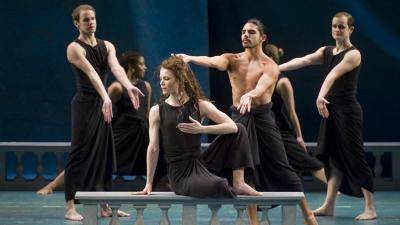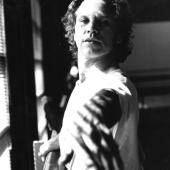MIX MATCH DANCE FESTIVAL, a series featuring mostly local companies, completed its fourth annual series of performances at the Electric Lodge in Venice this past weekend. The festival produced by Amanda Hart of Hart Pulse Dance Company offered a sprawling rather than focused two-act evening of solos and ensembles with a number of choreographers pulling double duty as dancers in their own works. While a series of this nature provides an important venue for L.A.'s choreographers it can also threaten an audience with a surfeit of dancing . When the program closed with Hart's own offering for the evening, a pas de deux titled MELT, I found myself trying to remember how the evening had begun. Other problems got in the way of easy enjoyment. A notable lack of lighting felt more like the inadequacy of the venue than a choice to create a specific onstage environment. A bank of lights hung upstage was pointed at the audience and proved a distraction for much of the evening. And though there were some entirely superfluous pieces on the program there were also bright spots which made you feel that lurking in the evening may have been a more satisfying arrangement for a two-act program of concert dance.
Here are some of the highlights. Laurie Sefton's excerpt from OUT OF LIFE, titled Terminal, proved a thoughtful if harrowing imagining of a soul enduring chemotherapy. The original three-part choreography danced by three different women deals with end of life issues. Terminal uses a classic acid solo by Jimi Hendrix; Gabrielle Tracy who danced the solo role found a powerful connection to the music and Sefton's concept with raw movement and powerful acting. Effective down pools of light reinforced the solitary struggle though there were moments when she was lost on an overly dark stage. A telling refrain of two fingers tapped across the forearm gave you the disquieting image of an IV patch and helped make the story real rather than just an abstracted vision. You could have wished for the whole piece. Other selections from Sefton's Clairobscur Dance Company appeared on the Friday and Sunday programs.
In MANDALBADDHA NARTAN, dancer Sohini Ray gave an expressive account of Manipuri Dance, a temple dance idiom translated here for the stage. Ample lighting gave us a chance to see the detailed use of feet, hand gestures, eyes and head direction in a classic and beautifully costumed version of the style. Ray's was the only choreography on the program straying far from modern and contemporary dance genres. Both the music and choreography are credited to her mentor and culture bearer, Bipin Singh.
Robyn Cohen and Jodie Mashburn were both choreographers and dancers in their piece, CONSTANT CONTACT, which featured the two dancers linked by their costumes. The opening section with clever intertwined, athletic movement gave way to a second section which proved less convincing in the clarity of its unison movement. They took away the evening's prize for sustained applause.
Jamal Story was the choreographer in Luminario Ballet's IF THE WALLS COULD SCREAM, an excerpted pas de six from the four section work based on music drawing on Fado, Tango, and Brazilian riffs. The tiny stage really limited the possibilities for this piece which without ample room to move made the choreography seem pose obsessed. The men's solo section proved more satisfying than a similar section for the women who were on pointe. Tattered toe shoes made it look of the favela rather than slick. You could have wished for a stripped down version under the circumstances. The partnering at times lacked security and the generic costuming up close made the dancers seem under-dressed. Damian Diaz and Ashley Hoffman provided exceptional dancing in this ensemble piece. It was seen in its entirety in August on Luminario's evening length program at The Ford Theater.
San Francisco based Moving Arts Dance was seen in the solo work MEDUSA, choreographed by company Artistic Director Anandha Ray and Paris Wages. The featured dancer, Terrin Kelly, was excellent in the role, striking fearsome attitudes and command- ing attention in her expressive floor work. Dim lighting, intended to evoke mystery, only tended to obscure both the dancer's face and costume and seemed a missed opportunity in the compact venue. The sound score, which used quasi tango and Indian music coupled with electronica, effectively enhanced the ritualized feeling of the movement. The music was not credited in the program notes.
Oddly DAMN THE MAN, choreographed by Molly Brictson in collaboration with her Dancers, provided the only piece of the evening in which constant movement and the use of every available inch of stage space and defying the confines of the Electric Lodge. This in itself is a good trick but all the more significant considering the four dances are tethered together for much of the choreography. Brictson and company manage some clever movement and weaving figures that remind you of finger string games. The unison movement was very effective throughout. You could have wished for more attention to costuming and a version of the concert rope rather than the rehearsal version. The dance crew were Eva Wieland, Aleksandra Wojda, Chisa Yamaguchi and Dana Vultaggio.
Misa Kelly in RANUNCULUS, Michael Battle in VICISSITUDES and Rebecca Bryant in CONTENT WITH CONTENT proved how different solos could be. Kelly, a woman slight in stature, proved an overwhelming and formidable presence on stage in her work which used her own vocalizations in a psychological journey. In the end she retreats into blackness with a series of looming balances. It was slightly terrifying. Bryant wandered the stage in a comedic piece that used publicity blurbs as a score... this dance is about... a staggering work of clarity. It was the only comedy of the evening and it was clever too. Battle's dancing with choreography by Ken A. Morris (music by Steve Reich) was a visitation to an old fashioned world of modern dance a la Horton and Graham. He is an exceptional dancer who muscled and finessed his way through a very demanding piece. He looked terrific in dress pants and red jersey in a kind of everyman solo that looked both without and within. It was classic and American in sensibility.
In PUSHING, a duo choreographed by Dorcas Roman, Carmen Rojo was moving and commanding in an uneven duo that overwhelmed her partner. The piece dealt with issues of relationships and domination. She walks away a clear victor in this one and delivers an emotional performance in the process.
MIX MATCH DANCE FESTIVAL presented different programs on Friday, Saturday and Sunday. There were more than three dozen companies presenting both new and old works. For more details you can visit website to see the lineups and additional details of the festival.
(The reviewed performance took place on September 11, 2010 at The Electric Lodge, Venice, California)




